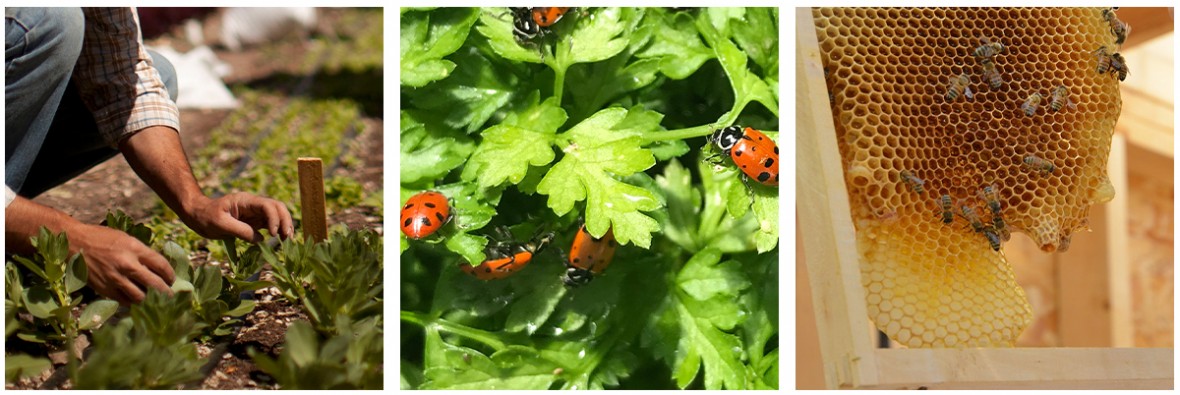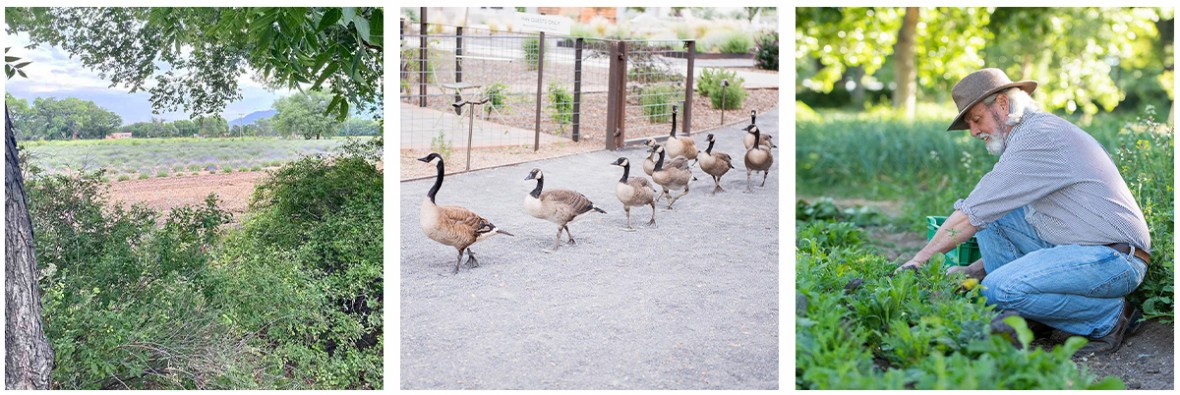
Here at Los Poblanos, we are proud to practice regenerative agriculture. Not only do we grow crops without chemicals, we also take action to give back to the land so that we leave the earth better than we found it. Our dedicated farm team works hard to incorporate five healthy soil principles in our daily practices, aiming to set in motion a cycle of healthier soil, healthier plants, healthier people and healthier ecosystems.

Principle #1: Keep Soil Covered
with plants or mulch
We use mulch like tree leaves and kitchen compost or living compost including cover crops like clover, sainfoin, vetch, field peas, buckwheat and daikon radishes. This natural mulch helps hold the soil together and adds or pulls up nutrients to make them available to the plants between seasons.
Principle #2: Minimize Disturbance of and Inputs to Soil
no chemical fertilizers, herbicides or pesticides
Property wide, our farm and gardens follow organic principles, and do not use chemical fertilizers, herbicides or pesticides. Instead, we use beneficial insects and organisms like lacewings, ladybugs, praying mantis and nematodes, or products like diatomaceous earth. We till the soil as little as possible, but when we do, it is mostly to incorporate organic matter into the heavy clay soil that our vegetables and flowers are grown in.
Principle #3: Maximize Biodiversity
both within the habitat and with pollinators
Our dense landscape incorporates both native plants and introduced species, and our organic practices encourage biodiversity. Birds, mammals, reptiles and even rodents aerate the soil while feeding snakes, hawks and owls. The wide array of plants, in bloom throughout the season, encourage pollinators of all sorts and provide nectar and pollen for our hives of honeybees.

Principle #4: Maintain Living Roots
through plant diversity
Our perennial plants, shrubs and trees have living roots in the soil year-round, encouraging microorganisms, beneficial fungi and mycorrhizae to establish webs of healthy living soil throughout the property. There are perennial borders, or hedgerows, surrounding and dividing our annual fields to stabilize soil and provide windbreaks as well as habitat for wildlife on the property.
Principle #5: Integrate Animals
both wild and domestic
The alpacas, sheep and chickens provide grazing and light soil disturbance while providing manure and bedding that is a vital part of our composting practice. The property hosts a large variety of bird species both year-round and migratory. Rabbits, squirrels, coyotes, raccoons, skunks and more roam the property and are part of our ecosystem management strategy that recognizes the importance of wildlife.
Wes' Gardening Tip
Practice these principles in your own home to build and maintain healthy soil. Cover soil with plants and mulches. Minimize soil disturbance and inputs such as chemical fertilizers and pesticides. Keep living roots in soil to hold soil in place and create space for healthy soil microorganisms. Maximize biodiversity, especially with plants. Keep or encourage animals in your landscape.
One teaspoon of rich garden soil can hold up to one billion bacteria, several yards of fungal filaments, several thousand protozoa and scores of nematodes. These are the crucial soil microorganisms that make growing healthy vegetables, herbs, landscapes and gardens possible.
-Wes Brittenham, Farm & Landscape Manager
